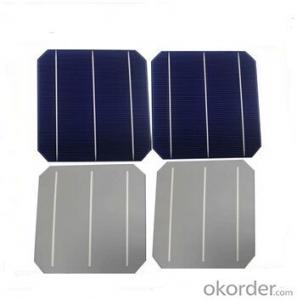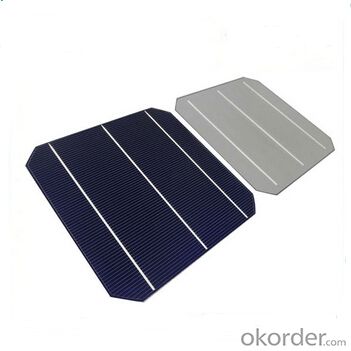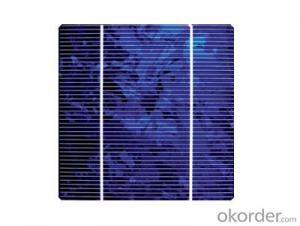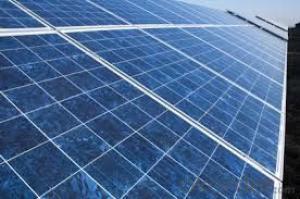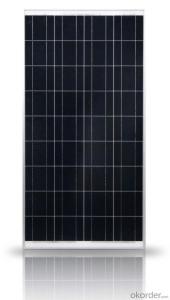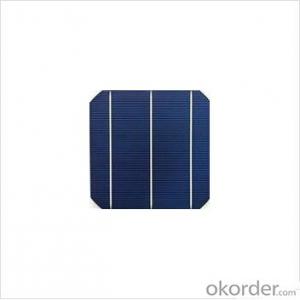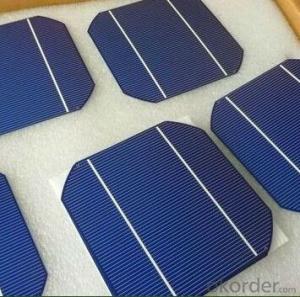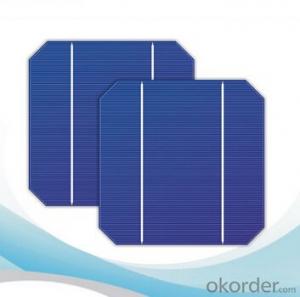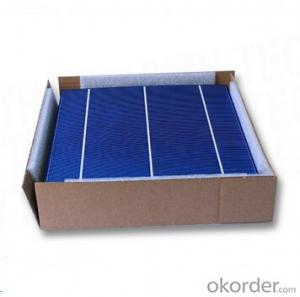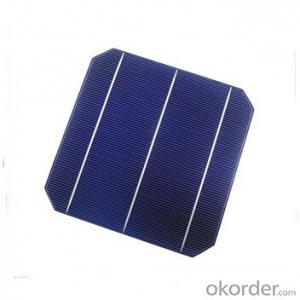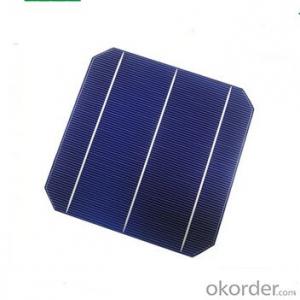High Quality Monocrystalline Solar Cells in Windows 16.40-17.60
- Loading Port:
- Shanghai
- Payment Terms:
- TT OR LC
- Min Order Qty:
- 1000 pc
- Supply Capability:
- 1000000 pc/month
OKorder Service Pledge
OKorder Financial Service
You Might Also Like
Solar Cells:
Solar cells is made by solar wafer, it has three categories of solar cell right now, monocrystalline polycrystalline and thin film,These cells are entirely based around the concept PN junction, which is the critical part of solar module, it is the part that can convert the light energy into electricity, the thickness is from 180um to 200um, with even busbars to conduct electricity, textured cell can decrease diffuse reflection; they are often electrically connected and encapsulated as a module. Photovoltaic modules often have a sheet of glass on the front (sun up) side, allowing light to pass while protecting semiconductor wafers from abrasion and impact due to wind-driven debris, rain, hail, etc. Solar cells are also usually connected in series in modules, creating an additive voltage. Connecting cells in parallel will yield a higher current;With high quality and stable quality. Our Cells can greatly improve the performance of Solar Modules.
Features:
1. High conversion efficiencies resulting in superior power output performance.
2. Outstanding power output even in low light or high temperature conditions
3. Optimized design for ease of soldering and lamination
4. Long-term stability, reliability and performance
5. Low breakage rate
6. Color uniformity
Solar Cells Advantage:
• High efficiency and stable performance in photovoltaic conversion.
• Advanced diffusion technique ensuring the homogeneity of energy conversion efficiency of the cell.
• Advanced PECVD film forming, providing a dark blue silicon nitride anti-reflection film of homogenous color and attractive appearance.
• High quality metal paste for back surface and electrode, ensuring good conductivity, high pulling strength and ease of soldering.
• High precision patterning using screen printing, ensuring accurate busbar location for ease with automatic soldering a laser cutting.
Specifications:
Dimensions | 156x156 mm |
Diagonal | 220 mm |
Cell Thickness | 180/200 ± 20μm |
Front | Blue silicon nitride anti-reflective coatings |
3x1.5mm silver busbar | |
Back | Full-surface aluminum back-surface field |
3x3.0mm (silver/aluminum) discontinuous soldering pads |
Electrical Characteristics | ||||||
Efficiency code | Efficiency Eff(%) | Power Pmax(W) | Max.Power Current Ipm(A) | Short Circuit Current Isc(A) | Max.Power Voltage Vpm(V) | Open Circuit Voltage Voc(V) |
1760 | 17.60 | 4.28 | 8.097 | 8.561 | 0.529 | 0.631 |
1740 | 17.40 | 4.23 | 8.035 | 8.506 | 0.527 | 0.629 |
1720 | 17.20 | 4.19 | 7.973 | 8.454 | 0.525 | 0.627 |
1700 | 17.00 | 4.14 | 7.910 | 8.398 | 0.523 | 0.625 |
1680 | 16.80 | 4.09 | 7.847 | 8.335 | 0.521 | 0.623 |
1660 | 16.60 | 4.04 | 7.769 | 8.267 | 0.520 | 0.622 |
1640 | 16.40 | 3.99 | 7.690 | 8.203 | 0.519 | 0.621 |
Packaging & Delivery of Solar Cells
Carton Box Package and Deliver by air. It should be noticed that it should be avoid of water, sunshine and moist.
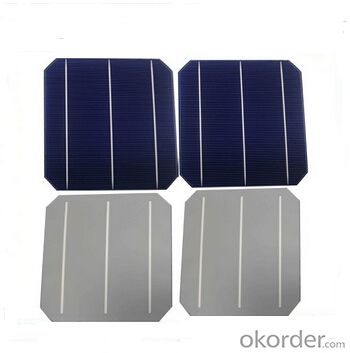
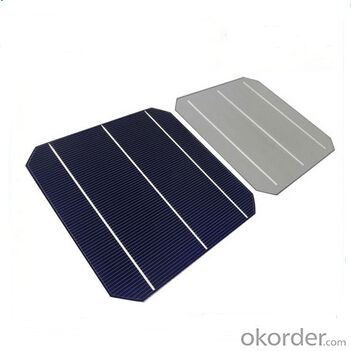
FAQ
We have organized several common questions for our clients,may help you sincerely:
①What price for each watt?
It depends on the efficiency of the solar cell, quantity, delivery date and payment terms.
②How long can we receive the product after purchase?
In the purchase of product within three working days, We will arrange the factory delivery as soon as possible. The pecific time of receiving is related to the state and position of customers.Commonly 7 to 10 working days can be served.
③Can you provide the peripheral products of the solar panels, such as the battery, controller, and inverter? If so, can you tell me how do they match each other?
Yes, we can, we have two companies for solar region, one is CNBM International, the other is CNBM engineering Co.
We can provide you not only the solar module but also the off grid solar system, we can also provide you service with on grid plant.
④What is your warranty of solar cell?
Our product can promise lower than 0.3% open box crack, we support claim after opening the box if it has crackm color difference or sth, the buyer should give pictures immediately, we can not accept the claim after the solar cell has assembled to solar panel.
• Timeliness of delivery
• ⑤How do you pack your products?
We have rich experience on how to pack the solar cell to make sure the safety on shipment, we could use wooden box or pallet as buyer's preference.
- Q: How can the solar power change our life by using solar cells material?
- There is a lot of research indicating that by the mass use of solar cells, the solar power is becoming one of the least expensive overall sources of power
- Q: Can solar cells be used in sports stadiums?
- Yes, solar cells can be used in sports stadiums. They can be installed on the roofs or facades of stadiums to generate renewable energy, reducing the reliance on traditional sources of electricity. This can help lower operating costs and reduce a stadium's carbon footprint. Additionally, solar cells can provide shade in outdoor stadiums, enhancing the spectator experience.
- Q: What is the difference between a solar cell and a solar panel?
- A solar cell is a single unit that converts sunlight into electricity, while a solar panel is a collection of multiple solar cells connected together to generate a larger amount of electricity.
- Q: How do solar cells compare to fossil fuel-based power generation?
- Solar cells are a more sustainable and environmentally friendly alternative to fossil fuel-based power generation. Solar cells harness the power of sunlight, a renewable energy source, to generate electricity, while fossil fuel-based power generation relies on the burning of finite fossil fuels like coal, oil, and gas. Solar cells produce clean energy, emit no greenhouse gases, and have little to no impact on climate change. Additionally, while fossil fuel-based power generation requires constant extraction and transportation of fuels, solar cells can be installed in various locations, making them more versatile and accessible. However, solar cells are currently less efficient and more expensive than fossil fuel-based power generation, which hinders their widespread adoption.
- Q: The advantages and effects of solar energy
- Solar batteries are widely used, such as artificial satellites, unmanned weather stations, communication stations, TV relay stations, solar clocks, electric pole, black light, beacon lights, railway lights. Solar thermal conversion technology products, such as water heaters
- Q: Can solar cells be used in water?
- Yes, solar cells can be used in water. Some solar panels are specifically designed to be used in water environments, such as floating solar panels used in reservoirs, lakes, and other bodies of water. These panels are waterproof and can efficiently generate electricity even when partially submerged.
- Q: Which Solar Panel Type is best? Polycrystalline panel or PV Module Monocrystalline Solar cell panel, or thin film?
- Monocrystalline solar panels live the longest. Most solar panel manufacturers put a 25-year warranty on their monocrystalline solar panels.
- Q: Can solar cells be used in electric fence systems?
- Yes, solar cells can be used in electric fence systems. Solar panels can generate electricity from sunlight, which can then be stored in batteries and used to power electric fences. This eliminates the need for a connection to the main power grid and makes electric fence systems more flexible and cost-effective in remote areas.
- Q: Can solar cells be recycled?
- Yes, solar cells can be recycled. The process involves separating the different components, such as glass, metals, and semiconductors, and reusing or repurposing them for new solar cell production or other industries. Recycling solar cells helps reduce waste and environmental impact while also conserving valuable resources.
- Q: How do solar cells perform in areas with high levels of dust storms?
- Solar cells can experience reduced performance in areas with high levels of dust storms. The accumulation of dust on the surface of solar panels can block sunlight and reduce the amount of energy they can generate. Regular cleaning and maintenance are necessary to ensure optimal performance in such regions.
Send your message to us
High Quality Monocrystalline Solar Cells in Windows 16.40-17.60
- Loading Port:
- Shanghai
- Payment Terms:
- TT OR LC
- Min Order Qty:
- 1000 pc
- Supply Capability:
- 1000000 pc/month
OKorder Service Pledge
OKorder Financial Service
Similar products
Hot products
Hot Searches
Related keywords
